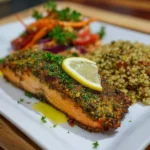Are you looking to optimize your nutrition, build lean muscle, maintain balanced blood sugar levels, or simply lead a healthier lifestyle? Protein could be the key nutrient you’re missing. In this in-depth guide, we’ll walk you through the importance of protein, show you how much you might need each day, and offer detailed meal ideas—breakfast, lunch, and dinner—so you can enjoy a full day of protein-packed meals. By the end, you’ll have a clearer understanding of why protein matters and how to incorporate it into your daily routine.
Table of Contents
- Why Protein Is Essential
- Understanding Your Daily Protein Intake
- High-Protein Breakfast Ideas
- Protein-Packed Lunch Options
- Delicious Dinner Choices
- Plant-Based and Animal-Based Protein Sources
- Tips for Optimizing Your Protein Intake
- Frequently Asked Questions
- Conclusion
Why Protein Is Essential
Protein serves as one of the fundamental building blocks for your body’s structure, aiding in everything from muscle repair and growth to immune system function. Here are a few reasons why you should make protein a focal point of your daily diet:
- Muscle Health and Growth: Protein is integral for repairing muscle tissue after workouts or day-to-day physical activities.
- Blood Sugar Regulation: Adding protein to your meals can help stabilize blood sugar levels, preventing energy crashes.
- Satiety and Weight Management: Protein-rich meals often help you feel fuller for longer, reducing the likelihood of overeating.
- Hormone and Enzyme Support: Proteins are involved in virtually all bodily functions, from hormone production to enzyme activity.
- Detoxification: Certain amino acids support the detoxification processes in the liver, helping your body manage toxins more effectively.
Understanding Your Daily Protein Intake
While individual needs may vary based on factors like age, activity level, and overall health, a general guideline for adults is about 1 gram of protein per kilogram of body weight, or roughly 0.5 grams per pound. Another easy way to approximate your daily protein goal: Daily Protein (in grams)≈Body Weight (in lbs)2\text{Daily Protein (in grams)} \approx \frac{\text{Body Weight (in lbs)}}{2}Daily Protein (in grams)≈2Body Weight (in lbs)
For example, if you weigh 150 pounds, you might aim for about 75 grams of protein each day. Always consider your specific health conditions and consult with a healthcare professional or registered dietitian for personalized advice.
High-Protein Breakfast Ideas
A protein-packed breakfast can set the tone for the rest of your day. Here are some options, as illustrated in the image:
- Egg (6g) and Whole-Grain Toast
- Top with a slice of lean bacon (3g) or a sausage patty (11g) for added protein.
- Sprinkle chia seeds (2g) and hemp seeds (3g) on top for extra nutrients.
- Oatmeal (6g) with Dairy Milk (8g) or Soy Milk (8g)
- Add almond milk (1g) if you prefer plant-based options, and toss in flaxseeds (2g) or pepitas (2g) for healthy fats and a small protein boost.
- Pair it with a protein powder (25g) mixed into your morning smoothie.
- Greek Yogurt (20g) and Berries
- A cup of Greek yogurt is naturally high in protein.
- Add fresh berries or a spoonful of peanut butter (8g per 2 tbsp) for flavor and more protein.
- Plain Yogurt (10g) With Toppings
- Drizzle honey or add banana slices for natural sweetness.
- Consider a sprinkle of nuts like almonds (6g per 1/2 cup) or walnuts (6g per 1/2 cup).
Why a High-Protein Breakfast Matters
- Satiety: Protein-rich breakfasts can keep you feeling satisfied until lunchtime, reducing mid-morning snack temptations.
- Energy Levels: Maintaining balanced blood sugar first thing in the morning can help you avoid energy dips later in the day.
- Nutrient Variety: Combining different protein sources (eggs, dairy, seeds, or plant-based alternatives) ensures you consume a wide spectrum of essential amino acids.
Protein-Packed Lunch Options
Lunch is a critical meal for sustaining your energy and focus throughout the afternoon. Incorporating protein into your mid-day meal can help prevent the post-lunch slump. Below are a few ideas from the infographic:
- Tofu (7g) and Edamame (17g)
- Tofu is versatile and easily absorbs the flavors of sauces and marinades.
- Edamame is a quick snack or salad addition that provides a substantial protein boost.
- Green Peas (8g) and Cottage Cheese (23g)
- Green peas can be added to salads, soups, or wraps.
- Cottage cheese pairs well with fruits like pineapple or berries.
- Parmesan (33g), Cheddar (21g), and Feta (12g)
- Cheeses can vary widely in protein content; adding a sprinkle to salads or sandwiches is a simple way to enhance flavor and protein.
- Pair different cheeses for a more interesting texture and taste.
- Peanut Butter (8g per 2 tbsp) and Nuts
- A peanut butter wrap or sandwich makes for a quick, satisfying lunch.
- Nuts such as peanuts (17g per 1/2 cup), almonds (6g per 1/2 cup), cashews (5g per 1/2 cup), or walnuts (6g per 1/2 cup) deliver healthy fats and additional protein.
Lunch Tips
- Combine Plant and Animal Proteins: If your diet allows, blend beans and tofu with small amounts of lean meats or cheese to maximize protein variety.
- Opt for Whole Grains: Whole-grain bread, quinoa, or brown rice can add fiber and a small amount of extra protein, improving overall meal quality.
- Layer Flavor With Herbs and Spices: Adding basil, oregano, garlic, or a dash of your favorite spice can elevate simple protein sources to delicious meals.
Delicious Dinner Choices
Dinner is often the largest meal of the day for many people. Making it protein-focused can help support overnight muscle repair and keep you feeling satisfied. Below are some meal ideas based on the infographic:
- Chicken (23g), Turkey (24g), or Beef (22g)
- Lean cuts of meat like chicken breast and turkey breast are excellent protein sources with lower fat content.
- Consider using herbs, spices, or a flavorful marinade to keep the meal interesting.
- Pork (23g) or Shrimp (20g)
- Pork tenderloin and shrimp offer high-quality protein.
- Shrimp can be stir-fried with vegetables and served over brown rice (5g) or quinoa (8g).
- Fish and Seafood:
- Tuna (24g): Ideal for quick salads or casseroles.
- Sardines (21g): A nutrient-dense choice rich in omega-3 fatty acids.
- Plant-Based Proteins:
- Lentils (18g), Chickpeas (15g), and Black Beans (15g) are hearty, high-protein legumes.
- Pinto Beans (15g) or Quinoa (8g) can round out a vegetarian or vegan dinner.
- Couscous (6g) is another easy-to-prepare grain option.
Sample Dinner Plate
- Grilled Salmon (approx. 20–25g depending on serving size)
- Steamed Vegetables (broccoli, carrots, zucchini)
- Brown Rice or Quinoa for complex carbs and added protein
- Fruit Slices (apples, oranges, or berries) for a nutritious dessert
- Optional Extras: Greek yogurt-based dressing or a dollop of cottage cheese for creaminess
Plant-Based and Animal-Based Protein Sources
There’s no one-size-fits-all approach to protein. Your choices may hinge on dietary preferences, ethical considerations, and health requirements. Below is a breakdown of both plant-based and animal-based protein sources to help you diversify:
- Animal-Based Proteins
- Poultry (chicken, turkey)
- Lean red meat (beef, pork)
- Fish and seafood (salmon, tuna, shrimp)
- Eggs
- Dairy products (milk, cheese, yogurt)
- Plant-Based Proteins
- Legumes (beans, lentils, chickpeas, peas)
- Tofu, tempeh, seitan
- Nuts and seeds (almonds, walnuts, chia seeds, hemp seeds)
- Whole grains (quinoa, barley, amaranth)
- Plant-based milks (soy milk, pea milk)
Balancing Amino Acids
Plant-based proteins can be combined to provide a complete amino acid profile—pairing grains with legumes (e.g., rice and beans) or seeds with legumes (e.g., chia seeds and lentils) can help ensure you get all the essential amino acids your body needs.
Tips for Optimizing Your Protein Intake
- Spread Your Protein Throughout the Day
- Instead of consuming all your protein in one meal, distribute it evenly across breakfast, lunch, and dinner.
- Prioritize Whole Foods
- While protein powders can be helpful, especially for those with higher needs, aim to get the bulk of your protein from whole food sources.
- Focus on Quality
- Lean meats and low-fat dairy products can reduce unwanted saturated fats.
- Choose minimally processed plant-based proteins to keep your diet nutrient-dense.
- Stay Hydrated
- Adequate water intake aids digestion and nutrient absorption.
- Pair Protein With Fiber
- Combining protein sources with vegetables, fruits, or whole grains (all high in fiber) can further support satiety and digestive health.
Frequently Asked Questions
1. How do I know if I’m getting enough protein?
Tracking your daily intake using a food journal or an app can provide insight. If you’re aiming for about 0.5 grams of protein per pound of body weight, log your meals to see if you reach that target.
2. Is it possible to eat too much protein?
Excessive protein intake can be taxing on the kidneys, especially if you have pre-existing kidney issues. Balance and moderation are crucial. If in doubt, consult a healthcare professional.
3. Can I achieve my protein goals without animal products?
Absolutely. Plant-based diets can still offer sufficient protein if you carefully plan meals. Foods like tofu, tempeh, lentils, beans, quinoa, nuts, and seeds are excellent options.
4. Do I need protein supplements?
Protein supplements can be convenient if you’re short on time or have higher protein requirements (e.g., athletes). However, they are not mandatory if you can meet your protein needs through whole foods.
5. What if I have specific dietary restrictions?
Always adapt protein recommendations to your individual health conditions—celiac disease, lactose intolerance, or food allergies will impact the types of protein you can consume. Consult a registered dietitian for personalized advice.
Conclusion
Protein is more than just a buzzword—it’s a foundational nutrient that supports muscle growth, blood sugar regulation, and overall well-being. By spreading your protein intake evenly throughout the day—starting with a hearty breakfast of eggs and seeds, moving on to a satisfying lunch of tofu, edamame, and wholesome cheeses, and finishing with a balanced dinner of lean meats or plant-based legumes—you can easily reach your daily protein targets.
Remember: Everyone’s needs differ based on age, lifestyle, and health goals. For personalized advice, talk to a healthcare provider or a registered dietitian. Whether you’re an avid athlete, a busy parent, or someone looking to improve their health one meal at a time, focusing on high-quality protein sources can make a significant difference in your overall vitality.
By following these guidelines and exploring the variety of protein-rich foods available, you’ll be well on your way to enjoying the benefits of a balanced, protein-focused diet. Here’s to feeling fuller, stronger, and more energized—one protein-packed meal at a time!
Disclaimer: The information provided in this article is for general informational and educational purposes only and is not a substitute for professional medical advice. Always consult a qualified healthcare professional to discuss your specific dietary and health needs.









